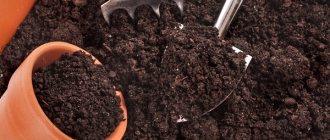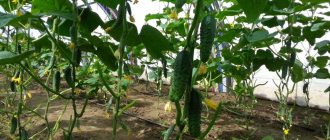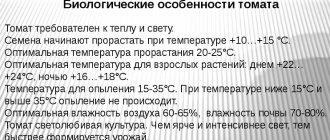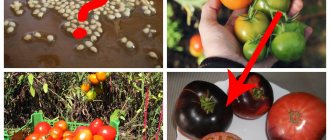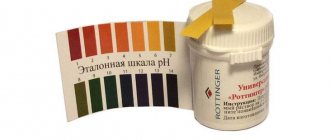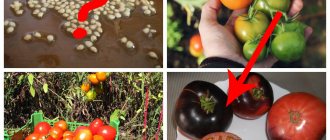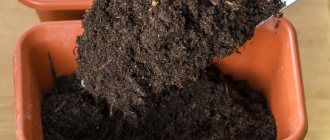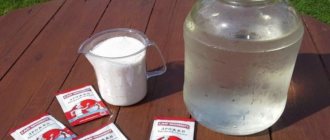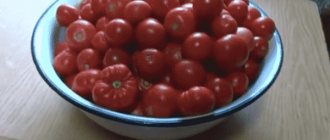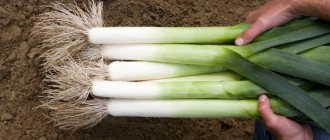For seedlings, the soil in which they will be grown is important.
But the soil, even purchased in a store, must be properly prepared before planting.
This is the key to good seedling growth and, in the future, a bountiful harvest. Which soil is better to choose, which one will be the best, and which one is better not to take at all? Let's figure it out together!
Soil requirements
The main requirement is that the soil must contain all the elements necessary for the development of seedlings.
The soil should be:
- Loose.
- It is good to allow moisture and air to pass through.
- Have sufficient, but not excessive amounts of nutrients.
- Have neutral or weak acidity.
- It should not contain toxic substances, harmful microorganisms, weed seeds, fungal spores, eggs or larvae of insect pests.
You cannot use soil from the garden where tomatoes, peppers, eggplants, and potatoes were grown. They also do not take soil from a greenhouse or greenhouse.
Is it possible to use soil from the garden for sowing?
There is no clear opinion regarding the suitability of garden soil for growing tomato seedlings. Some plant growers believe that garden soil is absolutely not suitable for seedlings, and they prepare or buy a special soil mixture. Others, at the same time, quite successfully grow seedlings using soil from the garden. However, it is rational to say that adding soil from the garden to the soil mixture makes it easier for seedlings to adapt to new conditions when transplanting them to the garden bed.
When using garden soil to grow seedlings, it is preferable to collect it from areas where cucumbers, zucchini, carrots, peas, beans, beans, and herbs grew. Soil taken from a mound dug by a mole around a hole is also suitable.
Components that should be included in the soil and which should not be
It is impossible to determine exactly which soil will be the best for tomato seedlings. Different varieties may like the presence of a certain component in the soil or, conversely, its absence. Much depends on the growing region.
Soil mixtures containing:
- Sod land.
- Meadow land.
- Peat.
- Rotted leaf humus (not from all types of deciduous trees).
- Rotted and frozen manure from cattle.
- Sphagnum moss.
- Garden land.
- Fallen pine needles.
- Coconut fiber.
- Rotten sawdust.
- Also included in the soil mixture is the presence of:
- Sand.
- Perlite.
- Hydrogel.
- Vermiculite.
- Some gardeners use substances such as:
- Wood ash.
- Chalk
- Dolomite flour.
- Lime.
Ash can protect against diseases, insect pests, and acts as a fertilizer and soil deoxidizer. But the usefulness of ash and its chemical composition depend on the type of wood being burned.
Should not be present in the soil:
- Fresh manure.
- Not rotted leaf humus.
- Insects, worms or weeds.
- Hay dust.
How to prepare substrate at home
Purchased soil does not always turn out to be of high quality and suitable in all respects.
Therefore, experienced summer residents prefer soil made by themselves.
To do this, you need polyethylene or tarpaulin, onto which the necessary components are poured in exact proportions, and then mixed.
First way:
- Soddy soil, peat and river sand are mixed in equal parts.
- A nutrient solution is prepared (10 l - water, 25-30 g - superphosphate and potassium sulfate, 10 g - urea).
- Water the soil mixture with this solution and let it dry.
Second way:
- Mix equal parts of turf soil, peat and humus.
- Pour two matchboxes of superphosphate and half a liter of wood ash into a 10-12 liter bucket.
- Mix everything thoroughly again.
Preparing the soil for planting yourself has its pros and cons.
Advantages:
- The necessary proportions are observed;
- saving money.
Flaws:
- Cooking takes time;
- If there is an error in the proportions, you will have to start all over again with new soil.
- It is not always possible to find all the necessary elements for a soil mixture.
- Harmful microorganisms may be present in the soil.
Disinfection of soil for seedlings
Often, having prepared the soil according to all the rules, after a while we notice that the seedlings begin to hurt. The main reason for this is the presence of pathogenic microflora in the soil, most often fungi. Therefore, it would be a good idea to disinfect the soil before sowing seeds.
This can be done at home in several ways.
- By freezing at low temperatures, leaving the seedlings in cold rooms where the temperature is close to outside;
- Calcination at high temperatures. To calcine the soil, spread it on a metal baking sheet in a layer of no more than 5 cm, pour boiling water over the soil, and then put it in the oven at a temperature of 70-90°C for half an hour. The temperature should not be higher than indicated, otherwise a higher temperature will lead to nitrogen mineralization and deterioration of soil quality.
- By steaming, pouring boiling water over the soil or pouring it into a colander, placing it over a pan of boiling water for 10 minutes;
- Etch with a pink solution of potassium permanganate. For more thorough treatment, antifungal drugs are used: Fitosporin, Baikal EM-1, Zamair, Vozrozhdenie;
- The soil spilled with a solution of potassium permanganate is placed in the microwave for 3 minutes, turning it on at full power.
All disinfection methods are good, but they all have one significant drawback: along with the pathogenic microflora, all the useful ones die. Therefore, such treatments are carried out 2-3 weeks before the intended use. You can store prepared and disinfected soil in an apartment until sowing seeds or picking seedlings.
What soil mixture is better to buy in the store?
To choose soil for tomato seedlings you need:
- Decide which primer is best suited for use, universal or special. For beginning gardeners, a soil mixture marked “universal” is suitable .
- Check the package with soil for a label with instructions for use, chemical and mechanical composition and information about the manufacturer. If this information is not available, then it is better not to purchase such a soil mixture.
- Good soil should consist of 3-4 elements : two types of peat, vermiculite or sand, mineral fertilizer. The amount of chemicals such as phosphorus, nitrogen, potassium should not exceed 300-400 mg/l.
- The soil purchased should be loose, without large lumps and not greasy. Water should drain well through such soil.
Benefits of Store Soil:
- The soil is almost ready for use.
- You can purchase the necessary packaging (from 1 to 50 liters).
- The composition is rich in all necessary elements.
Flaws:
- The amount of microelements is not always indicated correctly.
- Acidity is indicated approximately.
- Instead of peat, the manufacturer can add peat dust, which is not suitable for growing seedlings.
- You may get contaminated soil or with insect larvae.
Next, you can watch a video on how to analyze finished soil:
How to treat the soil before planting seeds for seedlings
By disinfecting the soil using thermal methods, some pathogenic microorganisms and insect eggs do not die. And in this case, it is useful to carry out disinfection with special means.
Fungicides are chemicals designed to combat fungal plant diseases. For this purpose, Fitosporin is used more often. To treat the soil, dilute 15 ml of working solution in 10 liters of warm water and water the soil. The following products are also used: “Planriz”, “Barrier”, “Extrasol”, “Glyokladin”.
Insecticides are chemicals designed to kill harmful insects. The following drugs are used: “Aktara”, “Inta-Vir”, “Thunder”, “Iskra”. The product is diluted in water. Before processing, the soil is loosened and moistened, and then watered with the prepared solution.
It is important to remember that any treatment with chemicals requires compliance with safety regulations and precise adherence to concentrations when administering solutions and its consumption. Treatment with products is carried out no later than 1 month before the intended sowing of seeds.
Disinfection of a small volume of soil is carried out by watering with a solution of potassium permanganate. To do this, 3-5 crystals of potassium permanganate are diluted in a small amount of water, stirred until the crystals are well dissolved, and then this solution is brought to a volume of 10 liters. Water the soil with a watering can, spending 30-50 ml per 1 square meter. m. Soil cultivation is carried out no later than 2 weeks before the proposed work.
Manganese is a strong oxidizing agent, so this disinfection method is not suitable for acidic soils.
How to prepare a substrate for planting at home
In order for the seedlings to develop well, the soil mixture must be prepared before planting.
Actions:
- Sift the soil . This removes large particles, enriches the soil with oxygen, and makes it light, which is good for the roots of the seedlings.
- Treat with cold . This treatment kills insect larvae and reduces the likelihood of further diseases to a minimum. It is best to stock up on soil in the fall, and freeze it outdoors and thaw it indoors several times during the winter.
- Before planting, add urea, rotted manure or compost to the warmed soil . If desired, wood ash and superphosphate are added. You can also add lime (15 grams per 1 kg of soil).
The treatment involves soil purchased in a store and prepared independently.
Checking the acidity level
You need to check the soil for acidity! How well the seedlings will feel depends on this. There are several ways to determine acidity:
Testing with litmus paper
A set of litmus strips with a color scale can be purchased at a specialty store.
You need to take some soil from several areas of the garden, from different depths. Wrap it in gauze and place in a vessel with distilled water for 5 minutes. There should be 4-5 times more water than the amount of soil.
Remove the gauze with soil from the container and place a litmus indicator there for 2-3 seconds. Compare the color of the strip with the pH values on the color scale.
Using vinegar
You need to dig a hole 20-25 cm deep, from below which take the required amount of soil. Roll the soil into a ball and place it on a plate. Pour vinegar onto the earth ball.
If there is lime in the soil, whitish bubbles will appear on the ball and a hissing sound will be heard. If the reaction is weak, then the soil has neutral pH values. If the reaction is strong, then the acidity of the soil is weak. A complete lack of reaction indicates that the soil is acidic.
Using grape juice
To determine the acidity of the soil, only natural grape juice is suitable.
Pour 50 mg of juice into a transparent container. Add some soil taken from the depths there. Monitor the reaction. If there is no reaction, then the soil is acidic. If the sap changes color slightly, bubbles slightly, and has a little foam on the surface, then the soil has a neutral pH value. A violent reaction indicates a low acidity level.
With chalk
Pour 2 tbsp of soil, 5 tbsp of water and 1 tsp of chalk into the bottle. Wrap the bottle in paper so that heat from your hands does not transfer to the water and the experiment is more accurate.
Attach a medical latex fingertip to the neck of the bottle. If the soil is acidic, the fingertip will fill with carbon dioxide and straighten out. With neutral acidity, it will not straighten completely. If the soil is slightly acidic, then the fingertip will remain in its original position.
Disinfection
By disinfecting the soil, gardeners destroy various pathogens. There are several ways to disinfect soil:
- Potassium permanganate . Prepare a weak solution of potassium permanganate (3 grams per 10 liters of water) and treat the soil with it.
- Steaming . Cover the top of the pan with water with a thick cloth and tie it so that it does not sag. Soil is poured onto the fabric. The pan is placed on a heating surface. When water boils, the soil begins to be treated with steam. This procedure must be carried out within half an hour.
- Calcination . Add boiling water to the soil and mix. Place a layer 5 cm thick on a baking sheet. Preheat the oven to 90-100 degrees. Place a baking tray with soil in it for half an hour.
Expert opinion
Ulanin Konstantin Grigorievich
Agronomist, work experience in the specialty - 12 years
Before planting, it is necessary to add bacterial fertilizer to the soil treated by calcination, since heat treatment kills not only harmful, but also beneficial microorganisms.
Universal soil with vermicompost - how to make it yourself
Organic matter in the soil is the most important condition for obtaining a decent harvest, especially at the stage of growing seedlings. In stores you can buy horse, chicken, and cow droppings. This is the same manure, but processed and in the form of granules. The use of such fertilizers is not always convenient, since they are granular. Therefore, it is much more convenient to use vermicompost for these purposes.
Many ready-made soils that are sold in stores are made from peat, and they are poorly nutritious, as they contain little organic matter.
Vermicompost is an organic fertilizer processed by worms. When worms pass organic waste through themselves, they disinfect it and convert all organic components (nitrogen, potassium) into a more digestible form, enveloping it in a film of calcium. This allows the fertilizer not to be washed out of the sandy soil, but to work for quite a long time, up to 5-6 years. Vermicompost contains up to 30-35% humic acids, which is 5-7 times more than in chernozem.
With a lack of organic fertilizers, after 2-3 weeks you can notice that the growth of seedlings has stopped, the leaves begin to turn pale, and the plant itself begins to wither. Therefore, when planting seeds of peppers, eggplants, tomatoes, cucumbers, it is very good to add at least 20% vermicompost to the soil. This will provide additional nutrition to the plants. That is, to 10 liters of soil that you have already prepared, you need to add 2 liters of vermicompost, mix and plant seedlings in such soil.
A universal soil with the addition of vermicompost is vermicompost. The seedlings planted in it develop well, the leaves have a healthy green color, and the plant develops well.
The best compositions for tomatoes
The stores have a large selection of soil mixtures from different manufacturers. Often gardeners are faced with the question of which soil is best. Here are just some popular types:
- Soil mixture “Living Earth” . The basis of the mixture is peat. Suitable for planting seeds and seedlings for all types of plants. Can be used as fertilizer. Available in universal, special and floral types. Cost from 300 to 400 rubles per 15 kg.
- Soil mixture “Microgreenhouse” . A universal soil, time-tested. Suitable for growing any plants. With such soil, germination increases and productivity increases. Cost from 45 to 120 rubles per 10 kg.
- Agricola soil mixture . A universal soil that accumulates and partially releases nutrition to seedlings. Contains high-moor peat, which facilitates easy access of oxygen to the root system and retains moisture in the soil. The composition includes all the minerals necessary for plant seedlings. Cost from 70 to 100 rubles per 6 kg.
